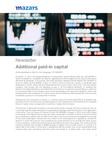
Additional paid-in capital
On March 17, 2017, the Superintendence of Corporations issued Official Letter No. 220-060094 in which it modified (or "collected") its doctrine regarding the rules to determine the value of the shares delivered as dividends. In this sense, the entity expressly repealed Official Notices 220-0140624 of June 18, 2008 and 220-063905 of April 14, 2016 in which it held that, if profits or dividends were distributed in shares, these had to be delivered at their nominal value, since only in this way did the company "fully comply with the obligation to pay in full the dividend declared". In revoking this doctrine, the Superintendency concluded that, since there is no express rule prohibiting it, and since it is convenient both for the company and for the shareholders who receive the dividend, "these may be delivered to their recipients for a higher value, and the difference that exceeds the nominal value constitutes a premium in the placement of shares".
Although the final conclusion is shared, i.e., that the value of the share delivered as a dividend may be higher than the nominal value, the legal support of such statement is not shared when it is indicated that such higher value corresponds to a premium in placement of shares.
The premium in placement of shares is an accounting and tax concept, but not a commercial one, so it is strange that the Superintendence of Corporations develops extensive theories on the application of the same. Thus, by means of External Circular 220-000008 of August 1, 2014, such entity, based on the study of the impact of the tax law (tax reform contained in Law 1607 of 2012) on the commercial law, and based on articles 384 and 386 of the Code of Commerce (articles that establish the concept of the share subscription contract and the content of the share placement regulations) revoked its doctrine, in which the premium was considered as a profit and went on to consider the same as part of the contribution, and therefore assimilating its treatment to that of the capital. The commercial law nowhere mentions the concept of additional paid-in capital; it only evokes it when, in numeral 4 of article 386 of the Code of Commerce, it establishes that the shares may not be issued below their nominal value, thus insinuating that when these are issued for a higher value, such value would constitute additional paid-in capital. On the contrary, the accounting and tax legislation extensively develops the concept of additional paid-in capital. ) the premium in placement of shares (...) is part of the contribution and, therefore, shall be subject to the same tax rules applicable to the capital, among others, it shall integrate the tax cost with respect to the shares or quotas raised exclusively for the one who contributes it and shall be reimbursable under the terms of the commercial law (...)".
From the above, it is clear that the premium in placement of shares is the greater value effectively paid by the shareholder, in excess of the nominal value, when acquiring shares issued by the company.
In this sense, and as the Superintendency itself recognizes, this concept arises from the share subscription contract and must necessarily be included in the placement regulations, since it is there where the company offers the shares for a value higher than the nominal value. Having said this, it is clear the conceptual error in which the Superintendence of Corporations incurs when it establishes that although the payment of dividends in shares is not an operation that starts from the stock subscription contract (correct premise up to that point), if the shares are delivered for a higher value than the nominal value, such difference in value should be recognized as a premium in the placement of shares. Such statement is incorrect since the premium in placement of shares -as indicated- is a greater value paid (over the nominal value) by the shareholder acquiring the shares, but never by the company, which, in a stock dividend payment operation, is the paying entity.
In this sense, such difference with the nominal value of the shares, when these are delivered as payment of a dividend, and for accounting purposes, must bear another name (as a sub-account in the surplus), but never that of premium in placement of shares.
This discussion is neither innocuous nor irrelevant, since the law itself indicates the tax treatment that must be given to the additional paid-in capital, which would distort such concept if the position adopted by the Superintendency were accepted.
In this sense, if such position were accepted, we would reach the absurdity of (i) being able to capitalize a supposed premium coming - not from the payment of shares made by the shareholders - but from the payment of dividends in shares made by the company itself, (ii) being able to reimburse the shareholders such supposed premium, which would not have as origin the payment made by them, but by the company itself, (iii) offsetting losses with a supposed premium not contributed by the shareholders but coming from the payment made by the company.


